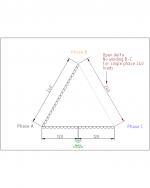kwired
Electron manager
- Location
- NE Nebraska
- Occupation
- EC
I was going to say maybe he didn't know the actual voltage, but then there likely was step down transformer(s) to get 120 volts somewhere and that should have at least been a clue.I looked at one job, brand new store (takeover existing building) someone put in an entire 208 volt switchgear on 480 volts! Gear had to be less than 10 years old. How they got it past inspections and energized I don’t know, unless the inspector didn’t know it was going to be 480. Had to give a quote on ripping it out and replacing.


